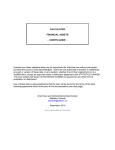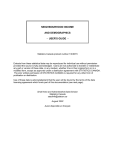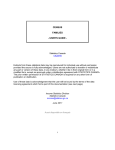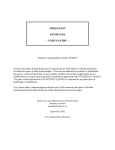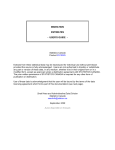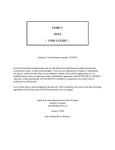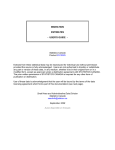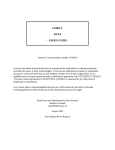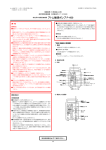Download User's Guide - Charitable Donors
Transcript
Charitable Donors - User's Guide - Statistics Canada Product number 13C0014 Extracts from these statistical data may be reproduced for individual use without permission provided the source is fully acknowledged. Users are not authorized to transfer or redistribute any part or version of these data, in any medium, whether it be in their original form or in a modified form, except as approved under a distribution agreement with STATISTICS CANADA. The prior written permission of STATISTICS CANADA is required for any other form of publication or distribution. Use of these data is acknowledgment that the user will be bound by the terms of the data licensing agreement which forms part of this documentation (see following page). STATISTICS CANADA Small Area and Administrative Data Division [email protected] October 2003 Aussi disponible en français END-USE LICENCE AGREEMENT COPYRIGHT The Government of Canada (Statistics Canada) is the owner or a licensee of all intellectual property rights (including copyright) in this data product. In consideration of your payment of the requisite fee, you or your organisation, as the case may be, (hereinafter referred to as the "licensee") are granted a non-exclusive, non-assignable and nontransferable licence to use this data product subject to the terms below. This license is not a sale of any or all of the rights of the owner(s). TERMS OF USE 1. All copyright and proprietary notices and all conditions of use associated with the data product must be communicated to all users of the data product. 2. The licensed organisation shall not transfer this data product to or store the data product in any electronic network for use by more than three (3) users unless it obtains prior written permission from Statistics Canada and pays any additional fees. 3. The licensee shall not lend, rent, lease, sub-licence, transfer or sell any part of the data product nor any right granted under this agreement to any person outside the licensed organisation or to any other organisation. 4. The licensee shall not disassemble, decompile or in any way attempt to reverse engineer any software provided as part of the data product. 5. The licensee shall not use any part of the data product to develop or derive any other data product or data service for distribution or commercial sale. 6. The licensee is granted reasonable rights of use of the content of this data product only for personal, corporate or public policy research, as well as for educational purposes. This permission includes the use of the content in analyses and the reporting of results and conclusions, including the citation of limited amounts of supporting data extracted from the data product in such documents. In such cases, the source of the data must be acknowledged in all such documents and communications by providing the following source citation at the bottom of each table and graph: Source (or "Adapted from", if appropriate): Statistics Canada, name of product, catalogue number of product, reference date of product. 7. The Licensee shall obtain approval from Statistics Canada, before publishing any significant volumes of material extracted from the data product in any medium. 8. Any violation of this license renders it void and of no effect. This agreement will terminate automatically without notice if the licensee fails to comply with any term of this agreement. In the event of termination, the licensee must immediately return the data product to Statistics Canada or destroy it and certify this destruction in writing to Statistics Canada. WARRANTIES AND DISCLAIMERS This data product is provided "as-is", and Statistics Canada makes no warranty, either express or implied, including but not limited to, warranties of merchantability and fitness for a particular purpose. In no event will Statistics Canada be liable for any direct, special, indirect, consequential or other damages however caused. ACCEPTANCE OF TERMS It is YOUR RESPONSIBILITY to ensure that your use of this data product complies with these terms and to seek prior written permission from Statistics Canada for any uses not permitted or not specified in this agreement. Any infringement of Statistics Canada's rights may result in legal action. ANY USE WHATSOEVER OF THIS DATA PRODUCT SHALL CONSTITUTE YOUR ACCEPTANCE OF THE TERMS OF THIS AGREEMENT. For further information please contact: Licensing Services Marketing Division, Statistics Canada R.H. Coats Building, 9th floor, section A Ottawa, Ontario K1A 0T6, Canada E-mail: [email protected] Telephone: (613) 951-1122 Fax: (613) 951-1134 © Statistics Canada, 2002 ii TABLE OF CONTENTS INTRODUCTION ....................................................................................................................... 4 The content of the databank .......................................................................................... 5 DATA SOURCE ......................................................................................................................... 7 DATA FREQUENCY .................................................................................................................. 7 DATA QUALITY ......................................................................................................................... 7 i) Number of Canadian taxfilers..................................................................................... 7 ii) Elderly population...................................................................................................... 8 iii) Income...................................................................................................................... 9 CONFIDENTIALITY AND ROUNDING .................................................................................... 10 SUPPRESSED DATA .............................................................................................................. 10 GLOSSARY OF TERMS.......................................................................................................... 11 STATISTICAL TABLES ........................................................................................................... 13 Footnotes and Historical Availability ............................................................................ 13 GEOGRAPHY .......................................................................................................................... 14 Geographic Levels - Postal Geography ....................................................................... 15 Adding postal areas without duplication ........................................................... 20 Concordance files............................................................................................. 22 Old walk/new walk file ...................................................................................... 22 Geographic Levels - Census Geography ..................................................................... 24 Geographic Levels - Special Geography ..................................................................... 26 Conversion files ................................................................................................ 27 WE INVITE YOUR COMMENTS ............................................................................................. 29 LIST OF DATA PRODUCTS AVAILABLE ............................................................................... 30 REGIONAL REFERENCE CENTRES ..................................................................................... 31 iii INTRODUCTION Line 340 - Charitable Donations This databank provides information on taxfilers classified as charitable donors. Charitable donors are defined as taxfilers reporting donations on line 340 of the tax return. Persons making charitable donations, but not reporting them on their personal tax return are, of course, not included in this databank. Only donations made to approved organizations are allowable as deductions in the tax system. Donations are eligible if made to Canadian registered charities and Canadian amateur athletic associations. They are also eligible if made to: prescribed universities outside Canada; certain tax exempt housing organizations in Canada; Canadian municipalities; the United Nations; and certain charities outside Canada to which the Government of Canada has made a gift. It is possible to carry donations forward for up to five years after the year in which they were made. In the reference year, it is possible to claim donations made in any of the previous five, as long as they were not already claimed in a prior year. The donations made in the reference year could be claimed the same year, or could be carried forward to any of the next five years. Some eligible donations may not have been claimed by taxfilers. These include donations for which no receipt was provided and donations for which the receipt was lost. No estimate of such donations is included in these data. A change in tax regulations was introduced in 1994. Taxfilers contributing to a recognized charity (as outlined above) were eligible to claim a tax credit of 17% of their donations on the first $200, and 29% on the rest. Previously, taxfilers had to give $250 to charity before the 29% credit was available. 4 The content of the databank is as follows: Table 1: Summary Column 1 - City identification number Column 2 - Postal area Column 3 - Postal walk number Column 4 - Level of geography (see Geography section) Column 5 - Place name Column 6 - Total Number of taxfilers Column 7 - Number of charitable donors Column 8 - Average age of donors Column 9 - Average donation for age group 0-24 Column 10 - Average donation for age group 25-34 Column 11 - Average donation for age group 35-44 Column 12 - Average donation for age group 45-54 Column 13 - Average donation for age group 55-64 Column 14 - Average donation for age group 65+ Column 15 - Total amount of charitable donations (thousands of $) Column 16 - Median donation Column 17 - Median total income of donors Column 18 - 75th percentile of donors' total income Table 2: Age and Sex (new beginning with 1995) Column 1 - City identification number Column 2 - Postal area Column 3 - Postal walk number Column 4 - Level of geography (see Geography section) Column 5 - Place name Column 6 - Total Number of taxfilers Column 7 - Percent of taxfilers who are male Column 8 - Percent of taxfilers who are female Column 9 - Number of charitable donors Column 10 - Percent of charitable donors who are male Column 11 - Percent of charitable donors who are female Column 12 - Percent of donors 0 - 24 years of age Column 13 - Percent of donors 25 - 34 years of age Column 14 - Percent of donors 35 - 44 years of age Column 15 - Percent of donors 45 - 54 years of age Column 16 - Percent of donors 55 - 64 years of age Column 17 - Percent of donors 65+ years of age Column 18 - Total median donation Column 19 - Median donation of males Column 20 - Median donation of females Column 21 - Total amount of charitable donations (thousands of $) Column 22 - Total amount of charitable donations for males (thousands of $) Column 23 - Total amount of charitable donations for females (thousands of $) 5 Table 3: Income Groups (new beginning with 1997) Column 1 - City identification number Column 2 - Postal area Column 3 - Postal walk number Column 4 - Level of geography (see Geography section) Column 5 - Place name Column 6 - Total number of taxfilers Column 7 - Total number of charitable donors Column 8 - Percent of charitable donors with total income less than $20,000 Column 9 - Percent of charitable donors with total income $20,000+ Column 10 - Percent of charitable donors with total income $40,000+ Column 11 - Percent of charitable donors with total income $60,000+ Column 12 - Percent of charitable donors with total income $80,000+ Column 13 - Total value of charitable donations (in thousands of dollars) Column 14 - Percent of donations reported by donors with total income under $20,000 Column 15 - Percent of donations reported by donors with total income $20,000+ Column 16 - Percent of donations reported by donors with total income $40,000+ Column 17 - Percent of donations reported by donors with total income $60,000+ Column 18 - Percent of donations reported by donors with total income $80,000+ 6 DATA SOURCE The data are derived from income tax returns. For the most part, tax returns were filed in the spring of the year following the reference year. For example, for the 2002 tax year, income tax returns were filed by April 30, 2003. The mailing address at the time of filing is the basis for the geographic information in the tables. Postal codes may have been revised or updated based on the geography file. Demographic characteristics such as age are given as of December 31 of the tax year. Income information is for the calendar year under review. DATA FREQUENCY Data are updated on an annual basis. DATA QUALITY i) Number of Canadian taxfilers The data used are direct counts from tax files. For the 2002 tax year, 21,979,210 Canadians (or 70% filed tax returns). 7 FIGURE 1 - NUMBER OF CANADIAN TAXFILERS Tax year Number of Taxfilers ('000) Date of Population Estimate Population ('000) Coverage (%) 1991 18,786 April 1, 1992 27,983 66.9 1992 19,267 April 1, 1993 28,273 68.1 1993 19,882 April 1, 1994 28,618 69.5 1994 20,184 April 1, 1995 28,939 69.8 1995 20,536 April 1, 1996 29,261 70.2 1996 20,772 April 1, 1997 29,577 70.2 1997 21,113 April 1, 1998 29,893 70.6 1998 21,431 April 1, 1999 30,168 71.0 1999 21,893 April 1, 2000 30,665 71.4 2000 22,249 April 1, 2001 30,974 71.8 2001 22,804 April 1, 2002 31,315 72.8 2002 21,979 * April 1, 2003 31,559 69.6 Percent coverage is based on a comparison of the number of taxfilers in the Small Area and Administrative Data Division's taxfiler databank and the population estimates from the Statistics Canada publication Quarterly Demographic Statistics (catalogue no. 91-002), now available on the Statistics Canada web site www.statcan.ca. * The 2002 count of taxfilers is taken from a preliminary 2002 taxfile from the Canada Customs and Revenue Agency. ii) Elderly population Some elderly Canadians receiving only Old Age Security and Guaranteed Income Supplement do not file because they have low or no taxable income. However, with the introduction of the Federal Sales Tax (FST) Credit in 1986 and the Goods and Services Tax (GST) Credit in 1990, the percentage of the elderly population filing tax returns has increased. In 2001, approximately 98.7% of the population aged 65 and over filed tax returns, up from 75% in 1989. 8 FIGURE 2 - COVERAGE BY AGE AND PROVINCE, 2001 Rates of Coverage by Age under 20 20-24 25-29 30-34 35-39 40-44 45-49 50-54 55-59 60-64 65-74 75+ 102.1% 88.2% 88.5% 92.3% 96.7% 96.9% 95.7% 95.6% 92.4% 94.9% 99.1% 95.4% Total 96.2% Rates of Coverage by Province Newfoundland & Labrador Prince Edward Island Nova Scotia New Brunswick Quebec Ontario Manitoba Saskatchewan Alberta British Columbia Yukon Territory Northwest Territories Nunavut 97.9% 97.6% 96.5% 97.7% 97.9% 95.6% 98.3% 98.3% 97.0% 92.8% 96.0% 96.3% 95.2% Canada 96.2% Coverage rates are based on comparisons with the estimated population counts to July 1, 2002 from Statistics Canada catalogue number 91-213-XPB, Annual Demographic Statistics. SAADD counts are taken from the 2001 final databanks (T1 Family File), released in September 2003. iii) Income Persons with low income have no tax liability and are not required to file tax returns. However, with the introduction of the Child Tax Credit in 1978, the Federal Sales Tax (FST) Credit in 1986, the Goods and Services Tax (GST) Credit in 1990, and the Child Tax Benefits in 1993, persons with low income are likely to file tax returns to apply for these credits. 9 CONFIDENTIALITY AND ROUNDING All data are subject to the confidentiality procedures of rounding and suppression. To protect the confidentiality of Canadians, counts are rounded. Rounding may increase, decrease, or cause no change to counts. Rounding can affect the results obtained from calculations. For example, when calculating percentages from rounded data, results may be distorted as both the numerator and denominator have been rounded. The distortion can be greatest with small numbers. All reported amounts are rounded to the nearest thousand dollars. Since 1990, data cells represent counts of 15 or greater, and are rounded to a base of 10. For example, a cell count of 15 would be rounded to 20 and a cell count of 24 would be rounded to 20. Note: Counts represent the number of persons. Reported amounts are aggregate dollar amounts reported. SUPPRESSED DATA To maintain confidentiality, data cells have been suppressed whenever: - areas comprise less than 100 taxfilers; - cells represent less than 15 taxfilers1; - cells were dominated by a single filer. Suppressed data may occur: i) Within one area: - when one of the income categories is suppressed, a second category must also be suppressed to avoid disclosure of confidential data by subtraction (called residual disclosure); - when one of the gender categories is suppressed, the other gender category must also be suppressed to avoid residual disclosure; - when one age group category is suppressed, another age group must also be suppressed to avoid residual disclosure. ii) Between areas: - when a variable amount in one area is suppressed, that variable amount is also suppressed in another area to prevent disclosure by subtraction. 1 Likewise, the median income is omitted when the rounded count of a category is less than 30 (15 on either side of the median). 10 GLOSSARY OF TERMS 75th percentile Is the number, in a group of numbers ranked from highest to lowest, where one-quarter of the numbers fall above and three-quarters fall below. For example, if the 75th percentile of total income is shown as $60,000 this means that 25% of the population under review has a total income greater than or equal to $60,000 and 75% of the population has a total income less than or equal to $60,000. Age Is calculated as of December 31 of the reference year (i.e., tax year minus year of birth). Charitable donation Is the allowable portion of total donations, as reported on the income tax return. Charitable donor Is defined as a taxfiler reporting a charitable donation amount on line 340 of the personal income tax form. CityID Since names can be, in some cases, quite long and cumbersome for handling in electronic files, municipalities are given a city identification number. Level of geography Is a code designating the type of geographic area to which the information in the table applies. See the section on Geography for further information. Median Is the middle number in a group of numbers. Where a median income, for example, is given as $26,000, it means that exactly half of the incomes reported are greater than or equal to $26,000, and that the other half is less than or equal to the median amount. Median incomes in the data tables are rounded to the nearest hundred dollars. With the exception of "Total Income", zero values are not included in the calculation of medians for individuals. Suppressed data Are intentionally omitted because they breach confidentiality. All data counts under a certain number are suppressed along with the corresponding income amounts. If the count for one cell or component is suppressed, then corresponding income aggregates in another cell are also suppressed to avoid disclosure by subtraction (called residual disclosure). See the section on Confidentiality. Taxfiler Is an individual who filed a personal income tax return for the referenced year. 11 Total income is the reported amounts of income by taxfilers from any of the following sources: Labour income; Employment income; Wages, salaries and commissions; Other employment income as reported on line 104 of the tax form (tips, gratuities, royalties, etc.); Net self-employment income; Employment Insurance (EI) benefits; Pension income; Old Age Security/Net Federal Supplements (the latter including guaranteed income supplements and spouses' allowances since 1994); Canada/Quebec Pension Plans; Superannuation and other (private) pensions; Family Allowance benefits (up to and including 1992); Interest and other investment income; Dividend income; RRSP income (since 1999, includes only income of taxfilers 65+ years of age); Net limited partnership income; Net rental income; Other income (e.g. alimony, and incomes reported on line 130, such as fellowships, bursaries, grants, etc.); Federal Sales Tax (FST) credit (for 1989-1990 inclusive); Goods and Services Tax (GST) credit (beginning in 1990); Child tax credit (up to and including 1992); Canada child tax benefit (starting with 1993); Provincial refundable tax credits (beginning in 1994); Other non-taxable income (beginning in 1993); Workers' compensation payments; Social assistance payments; Guaranteed income supplements; Spouses' allowances. 12 STATISTICAL TABLES - Footnotes and Historical Availability Table 1: Summary - The summary table is available starting with the 1990 data, according to the postal geography. Census metropolitan areas (CMAs) are available starting with the 1993 data, census divisions (CDs) with the 1995 data and federal electoral districts (FEDs) with the 1997 data. - Changes were made to the age groups in 1991 and in 1997. Table 2: Age groups - Available starting with the 1995 data, for the postal geography and for CMAs. CDs are available starting with the 1995 data and FEDs with the 1997 data. - Changes were made to the age groups in 1997. Table 3: Income groups - Available in its current format starting with the 1997 data, for the postal geography, for CMAs, CDs and FEDs. 13 GEOGRAPHY The data are available for the following geographic areas. See “Statistical Tables - Footnotes and Historical Availability” for further details. The mailing address at the time of filing is the basis for the geographic information in the tables. Standard areas: Postal Geography - Canada - Provinces and Territories - Cities - Rural Postal Codes - Urban Forward Sortation Areas - Postal Walks Census Geography - Census Divisions - Census Metropolitan Areas - Federal Electoral Districts User-defined areas: Users may select a specific area of interest that is not a standard area for which data can be made available in standard format. To obtain data, provide us with a list of the postal codes for which data are required and we will provide the aggregated data. Of course, the area must satisfy our confidentiality requirements, or no data can be produced. See the “Special Geography” section for further information. 14 Geographic Levels - Postal Geography The various databanks compiled from the taxfile are available for different levels of the postal geography, and for some levels of the Census geography. Coded geographic indicators appearing on the data tables are shown below with a brief description. Level of Geography (L.O.G.) Postal Area 12 Canada 11 Province or Territory Total Description This level of data is an aggregation of the provincial/territorial totals (code 11). The national total is identified by the region code Z99099. This level of data is an aggregation of the following geographies within a province: City Totals...................................................................... Code 08 Rural Postal Codes........................................................ Code 09 Other Provincial Totals .................................................. Code 10 These totals are identified by a provincial/territorial postal letter, then a "990" followed by the province/territory code, as follows: Newfoundland and Labrador .......................................... A99010 Nova Scotia .................................................................... B99012 Prince Edward Island...................................................... C99011 New Brunswick ............................................................... E99013 Quebec ............................................................................J99024 Ontario............................................................................ P99035 Manitoba......................................................................... R99046 Saskatchewan ................................................................ S99047 Alberta ............................................................................ T99048 British Columbia ............................................................. V99059 Northwest Territories ...................................................... X99061 Nunavut .......................................................................... X99062 Yukon ............................................................................. Y99060 15 Level of Geography (L.O.G.) 10 Postal Area Other Provincial Total ("P" Pot) Description This level of data is an aggregation of small communities in the province that had less than 100 taxfilers, where these communities are combined into a "pot". Before 1992, it was identified by the same codes as the provincial/territorial totals, and only the "Delivery Mode" codes 2 and 3 distinguished between the two. To avoid this problem, starting with the 1992 data, an "8" appears after the provincial/territorial letter instead of a "9". The "9" will be reserved for the provincial/territorial total, as explained in 11 above. These "pot" codes are as follows: Newfoundland and Labrador .......................................... A89010 Nova Scotia .................................................................... B89012 Prince Edward Island...................................................... C89011 New Brunswick ............................................................... E89013 Quebec ............................................................................J89024 Ontario............................................................................ P89035 Manitoba......................................................................... R89046 Saskatchewan ................................................................ S89047 Alberta ............................................................................ T89048 British Columbia ............................................................. V89059 Northwest Territories ...................................................... X89061 Nunavut .......................................................................... X89062 Yukon ............................................................................. Y89060 09 Rural Postal Code (Not in City ) This level of geography pertains to rural communities that have one and only one rural postal code. These stand-alone rural postal codes can be identified by a "zero" in the second position of the postal code and a level of geography code 09. The 2002 databanks contain 4,121 areas coded as level of geography 09. 16 Level of Geography (L.O.G.) Postal Area 08 City Total Description This level of data is an aggregation of the following geographies for unique place names within a province/territory: Urban FSA (Residential)................................................ Code 03 Rural Route ................................................................... Code 04 Suburban Services ........................................................ Code 05 Rural Postal Code (within city) ...................................... Code 06 Other Urban Area .......................................................... Code 07 They have the following format: e.g., Edmonton = T95479; Regina = S94876. The pattern is the postal letter of the city plus "9" in the second position (indicating a total), followed by a 4 digit numeric code for the community (often called "CityID"). In general, postal cities do not coincide with census subdivisions. The 2002 databanks contain 953 areas coded as level of geography 08. 07 Other Urban Area (Nonresidential within city "E" Pot) This aggregation of data (or "pot") covers non-residential addresses within an urban centre and all other data not otherwise displayed. Commercial addresses, post office boxes and general delivery are included, as are residential addresses with too few taxfilers to report separately. They can be recognized by codes that are similar to the city totals, with a distinguishing difference: an "8" will follow the city postal letter rather than the "9" of the city total (e.g., Edmonton = T85479; Regina = S84876). The 2002 databanks contain 500 areas coded as level of geography 07. 06 Rural Postal Code (Within City) These data pertain to rural postal codes that belong to communities with more than one rural postal code. These occur in areas that were formerly serviced by rural delivery service and changed by Canada Post to urban delivery service or in communities served by more than one rural postal code. Rural postal codes of this type can be identified by a "zero" in the second position of the postal code and a level of geography code 06. The 2002 databanks contain 370 areas coded as level of geography 06. 17 Level of Geography (L.O.G.) 05 Postal Area Suburban Service Description Sparsely populated fringe areas of urban centres may receive their postal service from an urban post office by delivery designated as "suburban service". Their region code retains all six characters of the postal code. Suburban Services are usually near or on the perimeters of urban areas, and mail is delivered by a contractor to group mail boxes, community mail boxes and/or external delivery sites (e.g., kiosks, miniparks). The 2002 databanks contain 24 areas coded as level of geography 05. 04 Rural Route Reasonably well-settled rural areas may receive their postal service from an urban post office by delivery designated as "rural route". Mail is delivered by a contractor to customers living along or near well-defined roads. Their region code retains all six characters of the postal code. The 2002 databanks contain 879 areas coded as level of geography 04. 03 Urban FSA (Residential Area) The urban Forward Sortation Area (FSA, identified by the first three characters of the postal code) includes all residential addresses covered by the first three characters of a postal code in a particular urban area (not including levels 04 and 05). Only residential FSAs are considered for these databanks. This level of data is an aggregation of: Postal Walk.................................................................... Code 01 Other Postal Walk.......................................................... Code 02 An Urban FSA of this type can be identified by the FSA followed by three blanks. The 2002 databanks contain 1,854 areas coded as level of geography 03. 18 Level of Geography (L.O.G.) 02 Postal Area Other Postal Walk Description This level of data is an aggregation of urban residential postal codes unallocated to a letter carrier route and postal walks with less than 100 taxfilers. A postal walk record of this type can be identified by the FSA followed by three blanks, and the postal walk number "XXXX". The 2002 databanks contain 223 areas coded as level of geography 02. 01 Postal Walk This is the finest level of data and is an aggregation of urban residential postal codes allocated to a letter carrier route. A postal walk of this type can be identified by a region code which is the FSA followed by three blanks, and the postal walk number. An average FSA contains 11 walks. The 2001 databanks contain 20,119 areas coded as level of geography 01. 19 Adding postal areas without duplication Data files according to the postal geography will often contain subtotals and totals. Many data users need to add certain geographies in order to come up with a total for their particular area of interest. However, including subtotals during this process results in double-counting some populations, and this leads to an erroneous total. The following is a summary of which postal areas are aggregations in the standard postal geography. Postal walks (Level of Geography, or LOG 1) and walk pots (LOG 2) add up to urban Forward Sortation Areas (FSAs, LOG 3). Urban FSAs (LOG 3), rural routes (LOG 4), suburban services (LOG 5), rural postal codes within a city (LOG 6) and other urban areas (LOG 7) add up to city totals (LOG 8). City totals (LOG 8), rural postal codes not in a city (LOG 9) and other areas in a province (LOG 10) add up to provincial/territorial totals (LOG 11). Provincial/territorial totals (LOG 11) add up to the Canada total (LOG 12). Thus, using the Level of geography codes: 1+2=3 3+4+5+6+7=8 8 + 9 + 10 = 11 20 21 Concordance files A concordance file accompanies data that are aggregated by postal walk. This file lists all of the six-character postal codes for which there is information, and identifies the postal walk to which each postal code is assigned. An urban Forward Sortation Area (FSA) may be split between two or more municipalities, and so the FSA label as well as the city identification number (or CityID) becomes important parts of the geographic identifiers. It is a combination of CityID, FSA label and postal walk number that creates unique geographic identifiers. The concordance file consists therefore of the CityID, the FSA label (called the postal area), the postal walk number and the six-character urban postal code. By simply browsing the concordance file, one can determine which postal codes make up a given walk. The following illustration is an example of a concordance file. CityID Postal area Postal walk Postal code 6092 K1B 52 K1B3K5 6092 K1B 52 K1B3V5 6092 K1B 52 K1B4C6 6092 K1B 52 K1B4N7 6092 K1B 52 K1B4N9 6092 K1B 52 K1B4M8 6092 K1B 52 K1B4N9 Vintage of the postal walks The postal walks represented in the 2002 databanks were coded from a June 2003 Canada Post Corporation file with a January 2003 basefile. Old walk/new walk file Since postal walks are subject to change, we will also supply on request, along with postal walk aggregated data and the corresponding concordance file, a third file called the Old walk/New walk file. This file shows the percentage change in the postal walks between the date of the walks to which the data are attached and the latest such information available to us from Canada Post. This file compares the six-character urban postal codes that make up the postal walk at two different points in time. It shows the percentage of the postal codes from the original (old) walk that are included in the newer walk, and the percentage of the new walk that is derived from the old. The following illustration is an example of an old walk/new walk file. 22 Comparison Between Old Walks (Month XXXX) and New Walks (Month YYYY) CityID FSA Old walk # New walk # % of old included in new % of new derived from old 2434 K1B 50 50 94 74 2434 K1B 50 51 6 8 2434 K1B 51 50 33 26 2434 K1B 51 51 61 92 2434 K1B 51 57 6 5 2434 K1B 57 57 91 50 2434 K1B 57 58 9 100 2434 K1B 52 52 29 10 2434 K1B 52 60 71 100 2434 K1B 53 52 20 24 2434 K1B 53 53 60 100 2434 K1B 53 58 20 33 2434 K1B 54 54 93 83 2434 K1B 54 55 7 5 2434 K1B 55 55 100 89 2434 K1B 56 52 30 14 2434 K1B 56 56 70 100 2434 K1B 58 52 12 10 2434 K1B 58 55 12 5 23 Geographic Levels - Census Geography Data are also available for the following levels of the Census geography; the following table shows the coded designators for these geographies, as well as a brief description of each. Level of Geography Name Description 41 Census Metropolitan Area The general concept of a census metropolitan area (CMA) is one of a very large urban area, together with adjacent urban and rural areas that have a high degree of economic and social integration with that urban area. CMAs have an urban core population of at least 100,000, based on the previous census. There are 28 CMAs in the 2002 databanks: 001, St. John's, Newfoundland and Labrador 205, Halifax, Nova Scotia 310, Saint John, New Brunswick 408, Saguenay (formerly Chicoutimi-Jonquière), Québec 421, Québec, Québec 433, Sherbrooke, Québec 442, Trois-Rivières, Québec 462, Montréal, Québec 505, Ottawa-Gatineau (Québec part) 505, Ottawa-Gatineau (Ontario part) 521, Kingston, Ontario 532, Oshawa, Ontario 535, Toronto, Ontario 537, Hamilton, Ontario 539, St-Catharines-Niagara, Ontario 541, Kitchener, Ontario 555, London, Ontario 559, Windsor, Ontario 580, Sudbury, Ontario 595, Thunder Bay, Ontario 602, Winnipeg, Manitoba 705, Regina, Saskatchewan 725, Saskatoon, Saskatchewan 825, Calgary, Alberta 835, Edmonton, Alberta 932, Abbotsford, British Columbia 933, Vancouver, British Columbia 935, Victoria, British Columbia 24 Level of Geography Name Description 31 Federal Electoral District A federal electoral district (FED) refers to any place or territorial area represented by a member of Parliament elected to the House of Commons. There are 301 FEDs in Canada according to the 1996 Representation Order. The Representation Order is prepared by the Chief Electoral Officer describing, naming and specifying the population of each electoral district established by the Electoral Boundaries Commission and sent to the Governor in Council. The 2002 databanks contain 301 areas coded as level of geography 31. 21 Census Division A census division (CD) is a group of neighbouring municipalities joined together for the purposes of regional planning and managing common services (such as police or ambulance services). A CD might correspond to a county, a regional municipality or a regional district. CDs are established under laws in effect in certain provinces and territories of Canada. In other provinces and territories where laws do not provide for such areas (Newfoundland, Manitoba, Saskatchewan and Alberta), Statistics Canada defines equivalent areas for statistical reporting purposes in cooperation with these provinces and territories. The 2002 databanks contain 288 areas coded as level of geography 21. 25 Geographic Levels - Special Geography Clients may select geographical areas of their own definition; areas that are not part of the standard areas listed here (for example, bank service areas, retail store catchment areas). For this, clients must submit a list of the postal codes that make up their special area, and we will aggregate the micro data to correspond to that area of interest. Information ordered for special, or "user-defined" areas will be coded according to the following: Level of Geography Name Description 93 Total for all user-defined areas This level represents the sum total of all user-defined areas, and is the total of levels 91 and 92 described below. 92 Other user-defined areas This level of geography represents all user-defined areas that were too small, in terms of population; to have information compiled on those areas individually (i.e. fewer than 100 taxfilers). Such areas are grouped into this "other" category. 91 Special user-defined area Any area showing a code "91" is an area defined by a specific user according to that user's needs (for example, school catchment areas, health districts, etc.) 26 Conversion files When a client is interested in purchasing data for areas that are considered non-standard geography by Small Area and Administrative Data Division, a conversion file is usually necessary. A combination of postal codes making up one or more special area(s) is commonly referred to as a conversion file – an electronic file used by our staff to aggregate the different postal codes that make up the user-defined area. Simply provide us with the postal codes related to the area and we will compile the data (subject to our confidentiality restrictions). This list should include all postal codes for each area. This would apply only to an area that is not a standard area. It could include any one or a combination of areas whose boundaries are a combination of standard areas or a combination of postal codes. User-defined areas may be branch service or school catchment areas, neighbourhoods or almost any other region. Each postal code on a conversion file is linked to a corresponding area code. The postal code is used as the basis for the tabulation of economic and demographic data for each area. Refer to the example below for a typical conversion file received by the Small Area and Administrative Data Division. Postal code User Area A1A1A1 A1A1A2 A1A1A3 A1A1A4 A1A1A5 A1A1A6 A1A1A7 A1A1A8 A1A1A9 A1A1B1 A1A1B2 A1A1B3 A1A1B4 A1A1B5 A1A1B6 A1A1B7 A1A1B8 A1A1B9 A1A1C1 A1A1C2 A1A1C3 0001 0001 0001 0001 0001 0001 0002 0002 0002 0002 0002 0003 0003 0003 0003 0003 0004 0004 0004 0004 0004 27 Note: 1) The conversion file should have a record length of 10 bytes. The first six bytes should represent the postal code and the following four bytes should represent the user-defined area. 2) The postal code does not have a space between the third and fourth characters. 3) The user-defined area code is only four characters in length. Our system cannot accommodate user-defined areas with hierarchical levels. In the previous example, areas 0001 and 0002 could not add up to their own total, with areas 0003 and 0004 adding up to their own separate total. Generating this type of hierarchical information means submitting this conversion file to our programs several times and increasing costs. 28 WE INVITE YOUR COMMENTS! We are always working on ways to improve our products. The comments we receive concerning quality and presentation are essential to meet this objective. If you have any suggestions in this regard, we encourage you, the user, to provide us with your comments. Data in many forms Statistics Canada disseminates data in a variety of forms. In addition to publications, both standard and special tabulations are offered. Data are available on the Internet, compact disk, diskette, computer printouts, microfiche and microfilm and magnetic tape. Maps and other geographic reference materials are available for some types of data. Direct online access to aggregated information is possible through CANSIM, Statistics Canada's machine-readable database and retrieval system. How to obtain more information Inquiries about these data and related statistics or services should be directed to: Client Services Small Area and Administrative Data Division Statistics Canada Room 1306, Main Building Ottawa, Ontario K1A 0T6 Telephone: (613) 951-9720 Toll-Free (866) 652-8443 Fax: (613) 951-4745 Toll-Free (866) 652-8444 [email protected] The Advisory Services Division of Statistics Canada provides an information dissemination network across the country through nine regional Reference Centres. Each Reference Centre has a collection of current publications and reference documents that can be consulted or purchased, along with microcomputer diskettes, CD-ROMs, maps, and other products. Copying facilities for printed materials are available on site. Advisory Services provides a wide range of services: identification of your needs, establishing sources or availability of data, consolidation and integration of data coming from different sources and development of profiles, analysis of highlights or tendencies and, finally, training on products, services, Statistics Canada concepts and also the use of statistical data. Local reference centres are listed on the last page. You can also visit us on the web: http://www.statcan.ca. National enquiries line National telecommunications device for the hearing impaired Order-only line (Canada and the United States) National Toll-free Fax line 1-800-263-1136 1-800-363-7629 1-800-267-6677 1-877-287-4369 Standards of service to the public Statistics Canada is committed to serving its clients in a prompt, reliable and courteous manner and in the official language of their choice. To this end, the agency has developed standards of service which its employees observe in serving its clients. To obtain a copy of these service standards, please contact your nearest Statistics Canada Regional Reference Centre. 29 LIST OF DATA PRODUCTS AVAILABLE The Small Area and Administrative Data Division of Statistics Canada tabulates statistical data derived from administrative records - most notably, the taxfile. The resulting demographic and socio-economic databanks available are listed in the table below, along with their identifying product number and the usual release dates. Product name Product number Release date RRSP Contributors 17C0006 November RRSP Contribution Limits (Room) 17C0011 November Canadian Savers 17C0009 November Canadian Investors 17C0007 November Canadian Investment Income 17C0008 November Canadian Taxfilers 17C0010 November Canadian Capital Gains 17C0012 November Charitable Donors 13C0014 December Neighbourhood Income and Demographics 13C0015 July Economic Dependency Profiles 13C0017 July Labour Income Profiles 71C0018 July Families 13C0016 July Seniors 89C0022 July Migration Estimates 91C0025 September 30 ATLANTIC REGION Serving the provinces of Newfoundland and Labrador, Nova Scotia, Prince Edward Island and New Brunswick. Statistics Canada Advisory Services 1741 Brunswick Street 2nd Floor, Box 11 HALIFAX, Nova Scotia B3J 3X8 ONTARIO REGION Serving the province of Ontario except the National Capital Region. Statistics Canada Advisory Services Arthur Meighen Building, 10th Floor 25 St. Clair Avenue East TORONTO, Ontario M4T 1M4 Serving Alberta and the Northwest Territories: Statistics Canada Advisory Services Pacific Plaza, Suite 900 10909 Jasper Avenue N.W. EDMONTON, Alberta T5J 4J3 PRAIRIE REGION PACIFIC REGION This region has three Reference Centres serving the provinces of Manitoba, Saskatchewan, Alberta and the Northwest Territories. Serving the province of British Columbia and the Yukon Territory. QUEBEC REGION Serving the province of Quebec (except the National Capital Region) and the territory of Nunavut. Statistics Canada Advisory Services 200 René Lévesque Blvd. West Guy Favreau Complex 4th Floor, East Tower MONTREAL, Quebec H2Z 1X4 NATIONAL CAPITAL REGION Serving the National Capital Region. Statistics Canada Statistical Reference Centre (National Capital Region) R.H. Coats Building, Lobby Holland Avenue OTTAWA, Ontario K1A 0T6 Serving the province of Manitoba: Statistics Canada Advisory Services Via Rail Building, Suite 200 123 Main Street WINNIPEG, Manitoba R3C 4V9 Serving the province of Saskatchewan: Statistics Canada Advisory Services Park Plaza, Suite 440 2365 Albert Street REGINA, Saskatchewan S4P 4K1 31 Statistics Canada Advisory Services Library Square Office Tower 600-300 West Georgia Street VANCOUVER, British Columbia V6B 6C7































